By Victoria Sophie Hazebrouck
Deradicalization and Security Initiative, Friedrich-Alexander-University, Erlangen-Nuremberg PDF: v_hazebrouck_vigilance_KCWA2022
Covid-19 did not only restrict our daily lives, but it also brought the shadow pandemic of intimate partner violence (IPV) into the public discourse. Globally, every third woman experiences (sexual) abuse or assault from a (former/sexual/non-sexual) partner of hers during their lifetimes (WHO 2021). The issue of IPV worsened due to Covid-19 countermeasures such as lockdowns, curfews, or compulsory work from home – the consequences of these measures were increased financial strains and economic dependency on partner; no alternative location such as shelters for battered women (as they had limited capacity or were even temporarily closed due to hygiene restrictions). Ultimately this led to implementations of vigilance campaigns by governments and/or non-governmental organizations (NGOs) in many countries communicating the risk of domestic violence, but especially IPV against women (e.g. joint US and UK campaign “#listeningfromhome”; in India “#endlockdownviolence; in Germany “#strongerthanviolence”, see e.g. Illustration 1).
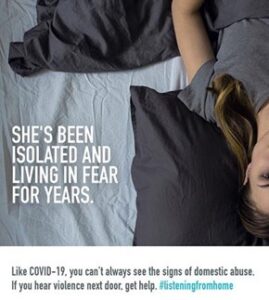
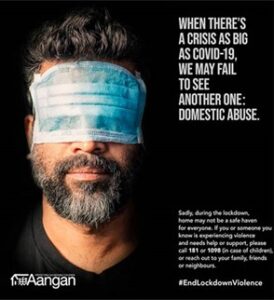
Illustration 1: Samples of VCs from the joint UK/US (top) and Indian (bottom) campaign (Kiefer 2020; Pantaleon 2020)
Vigilance Campaigns
Vigilance campaigns (VCs) call for vigilant surveillance in regard to a certain risk taking place by communicating such risk. This aims to establish a routine of citizens watching their environment and seeks to create a willingness to report to designated authorities. VCs are often considered to be purely awareness campaigns, and thus not usually described as VCs by political authorities. Yet, their distinctive aim to train citizens to be vigilant, open for peer-to-peer-monitoring and willing to share their observations to authorities exceeds the sole focus of creating awareness. In the context of IPV, citizens are requested to be vigilant in their neighbourhood, trying to spot signs of domestic violence, such as loud screams, injuries, bruises, or social menace in their fellow citizens. Those VCs entail memorable slogans, social-media-hashtags, support hotlines, or webpages with further information on how to react or to report. The advantages of VCs are not only that relevant reports of citizens can help in officially filed police reports in favour of the victim of IPV, but raised vigilance can also potentially deter further incidents and expand the gaze of authorities (cf. Larsen and Piché 2009, 191ff.). Furthermore, they bring awareness to the issue, which results in solidarity of the community with victims and encouragement for victims to report the perpetrator (cf. EIGE 2021, 31). VCs against IPV are often strategically placed in supermarket entrances or exits, churches, underground- and bus-stations. In Germany, in the wake of the first lockdown in 2020, even milk packaging of the supermarket chain Edeka read in German: “Not Safe At Home? Are you or anyone you know target of domestic violence? Visit the following webpage for further information and support”. (See Illustration 2). The same campaign can also be downloaded by citizens, who are encouraged to voluntarily spread self-printed posters in their own neighbourhood (BMFSFJ n.d.).
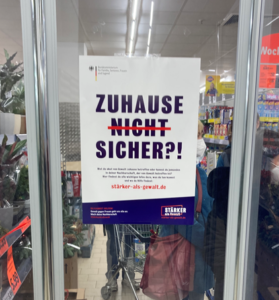
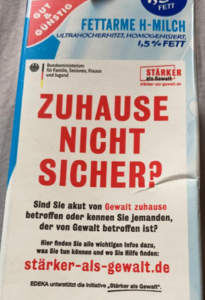
Illustration 2: Supermarket-Exit in Berlin, October 2021, and milk packaging from supermarket brand in August, 2020 (Pictures taken by author, 2020-2021)
In fact, VCs have their origin in neighbourhoods, as vigilant surveillance was implemented in the 1980s for neighbourhood- and street-safety reasons. One of the most-established concepts is the neighbourhood watch (Evans 2011, 14). Residents thought “that the police patrol [was] comparatively ineffective in providing protective surveillance” (Brantingham 1986, 105). It was considered more appropriate that residents themselves, being “pervasive, natural, unobjectionable watchers and guardians” (Ibid.), observed and reported suspicious activities in their neighbourhood. Its governmental institutionalisation, however, took place in the wake of the 9/11 terror attacks, when the United States (US) first implemented the VC “See Something, Say Something”. This later inspired the first British VC “If you suspect it, report it”, which was implemented by the Metropolitan Police Service (MPS) and its partners – the British Transport Police (BTP), the City of London Police, Transport for London (TfL), and the Mayor’s Office of London – after the 7/7 London bombings (Cf. Larsen and Piché 2009, 190; See Illustration 3).


Illustration 3: US-American (top) and British (bottom) counterterrorism-VC (Fernandez 2010; Salerno 2017, 97)
The “If you suspect it, report it”-campaign, one of the only VCs in the context of counter-terrorism measures in Europe (cf. Hazebrouck 2020, 840), was later exchanged for the “See it. Say it. Sorted”-VC. The campaign was mainly spread in public transit networks as they remain favourable targets for terrorist attacks given their easy accessibility and difficulty to implement “airport-style security screening” (Pearce et al 2019, 1). Interestingly, British Transport Police (BTP) launched a zero-tolerance campaign mid 2021 against sexual harassment, catcalling, exposing, upskirting, cyber-flashing, inappropriate touching and staring, which can be categorised as a VC. The campaign uses similar language to the counterterrorism VC “See it. Say it. Sorted” by stating “See it or experience it, text British Transport Police […]” (see Illustration 4). Passengers and rail staff are reminded to “Be aware, Be concerned, Listen, Reassure, and Report” (White Ribbon 2021). The latest campaign is also supported by the charity Crimestoppers, who support further VCs that encourage a speak-up culture when witnessing crimes in any form (Crimestoppers n.d.).

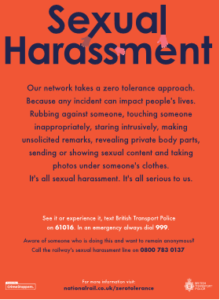
Illustration 4: Counterterrorism VC vs. Sexual Harassment VC of BTP (DfT 2016; National Rail n.d.)
It is important to highlight, nevertheless, that VCs, and with them especially the form of vigilant surveillance (that could be understood as a political institutionalised form of lateral surveillance), are not without criticism. VCs often refrain from picturing the exact risk or dangerous situation to avoid identifying a problem population (Cf. Fussey 2007, 176). This leads, however, to an unclear understanding of suspicious behaviour or individuals, which not only leads to lesser reports (Pearce et al 2019, 15) but could also result in reinforcing prejudices and racial stereotyping, given that, in a world where everyone is considered a potential suspect, citizens base their suspicions on (second-hand) experience, news and media portrayals of perpetrators (cf. Ivasiuc 2018, 11; Purenne 2017, 81).
In the past, European states have been reluctant to implement counter-terrorism VCs, as they fear scaring their citizens by communicating that their daily life could be at risk by possible terrorist attacks (cf. Pearce et al 2019, 1; Hazebrouck 2020, 840). In some countries peer-to-peer monitoring is seen critically in the context of their own past. The former German Democratic Republic (GDR), for example, employed their citizens under coercion, pressure, or promising of material incentives as so-called “unofficial collaborators” to spy on their fellow citizens and report them to the Ministry for State Security of the GDR (cf. Raschka 2001, 32-35). Here, it is noteworthy that VCs, however, do not coerce, pressure, or offer material incentives, but leave it to the citizens to voluntarily be vigilant and willing to report.
Conclusion
Despite the brief mentioned critiques, VCs are an important addition to surveillance methods that have their advantages over other surveillance forms. Especially in current times of Covid-19, where citizens are significantly more at home in their private sphere, warning signs or signs of abuse remain outside of the visible scope of the public. The increased vigilance and its success to act upon it can be seen in recent data by London’s Metropolitan Police that found that most calls reporting on domestic violence incidents came not from victims themselves but from third party callers (Office for National Statistics 2020). This is also supported by data from the German support hotline “Hilfetelefon – Gewalt gegen Frauen” that specifically consults on IPV incidents, who saw a rise of calls coming from the social network of a victim of IPV during 2020 (BAFzA 2021, 10). Citizens worldwide have become more aware of the issue – awareness that was created to a significant part by those campaigns. As the European Institute for Gender Equality (EIGE) finds, awareness-bringing campaigns (e.g. VCs) “are recognized as the most efficient and effective means of communicating information to the general public […] emphasizing the fact that domestic violence is not a private matter, but an unacceptable violation of human rights” (Ibid n.d.).